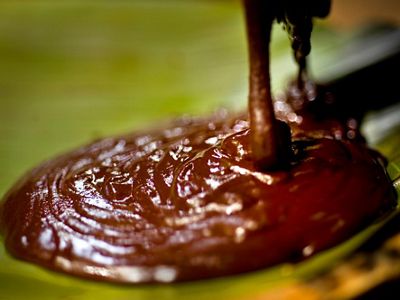To help restore the Amazon while providing better livelihoods, The Nature Conservancy (TNC) has pioneered an initiative to work with farmers plant sustainable agro-forests of cocoa trees, banana trees and a mix of native hardwood trees. Cacao has a high commercial value and is a remarkable alternative for producers to increase their incomes sustainably. TNC first started this initiative in 2012, in the municipality of São Félix do Xingú, in the southeast of Pará, with the Cacau Mais Sustentável (More Sustainable Cocoa) project, and aims to scale this solution to other municipalities in Pará and to other states in Brazil.
Quote: Benício Mariano Dutra
"It is through TNC that we have the technical support to farm the right way. This is very important to us. We are contributing to the preservation of nature and generating income."

The demand for chocolate production is growing worldwide. Today Brazil is the sixth largest producer of cocoa in the world, but still can not meet its domestic demand. Besides being a means of avoiding deforestation, cocoa plantations favor the local, regional and national economy.
Voices from the Field
"If you want this land, you need to deforest it."
That’s what Brazil’s federal government said to Benício Mariano Dutra 15 years ago when he moved to São Félix do Xingu, a city in Brazil’s state of Pará. Benício was promised 100 hectares if he promised to clear the forest and raise cattle.
Quote: BENÍCIO MARIANO DUTRA
The government told me cattle ranching was the best economic opportunity. In just a few years, I realized this wasn’t a good strategy because it wasn’t covering the cost of the land.
In hope of a better life and helping develop his country, Benício is one of many who moved to São Félix do Xingu at the encouragement of Brazil’s National Institute for Colonization and Agrarian Reform (INCRA).
Once blanketed with virgin rainforest that was home to indigenous peoples, São Félix do Xingu is now Brazil’s sixth largest municipality—nearly the size of Portugal—and holds the largest cattle herd in the country—over 2 million head.
The reality of cattle ranching in the Amazon rainforest is this: once the trees are cleared, the soil has few nutrients and is not suitable for growing grass pastures. This nutrient deficiency leads to a vicious cycle of deforestation: farmers clear the forest, plant grass seed, graze cattle, then the pasture becomes degraded and more forest is cleared to start the process all over again.
In 2008, São Félix do Xingu was at the top of Brazil’s “black list” of cities with the highest rates of deforestation and greenhouse gas emissions. Today, the city has reversed this trend and is at the top for the highest reduction in deforestation.

Sweet Success
Benício needed help. Cattle ranching was not paying the bills. He sought out advice from a local cooperative—CAPRU—who told him to plant cocoa trees, which are native to the Amazon rainforest and provide a stable income. Benício planted his first cocoa crop in 2004, and he’s planted three more since then.
The Nature Conservancy is working with farmers like Benício to plant sustainable agro-forests of cocoa trees, banana trees and a mix of native hardwood trees to help restore the rainforest while providing a better livelihood. Additionally, the Conservancy is teaching farmers practices that improve soil conditions for cattle ranching and in turn stop the deforestation cycle.
“Our goal is to reduce deforestation by 97 percent and remove São Félix do Xingu from the environmental black list,” said Rodrigo Mauro Freire, the Conservancy’s Amazon Forest & Climate Coordinator. “We hope this will at the same time improve the livelihoods of farmers, ranchers and local communities and provide a model for sustainable beef production and economic development in the Amazon.”
As our world’s population continues to grow, so does its need for food. The Conservancy believes through these combined efforts to improve soil conditions and reforest with native cocoa trees, Brazil can double its food production without habitat loss. This could ignite global change in our food supply chain and be a big win for people and for conservation.



